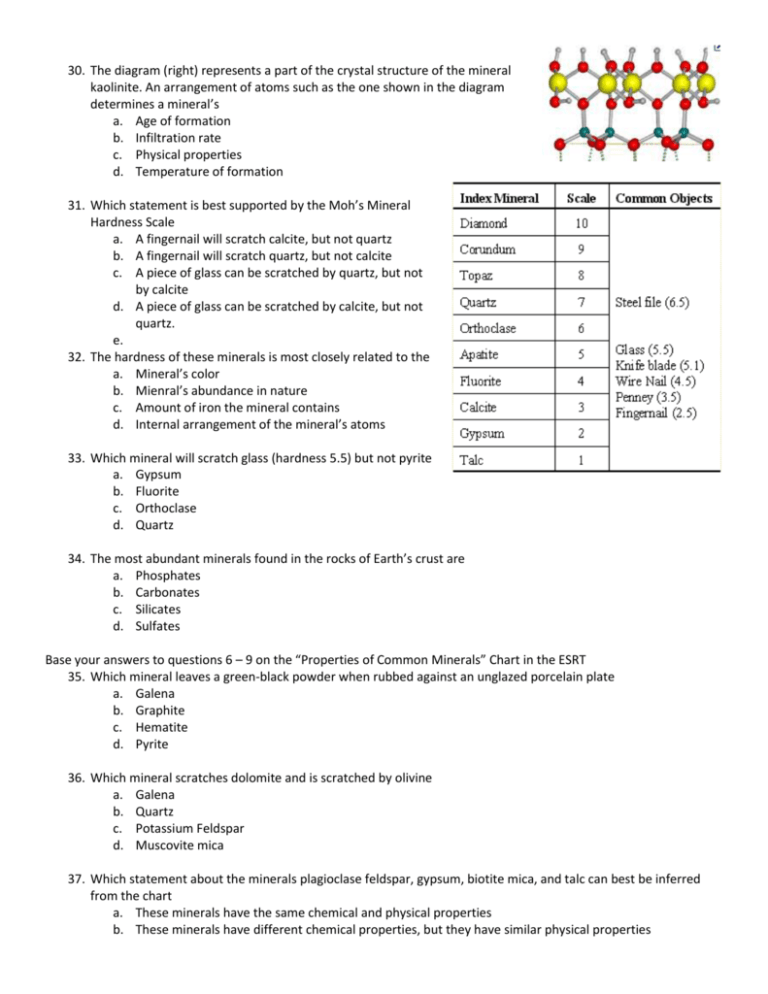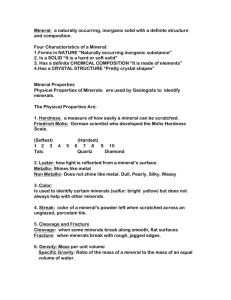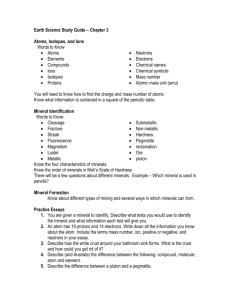The diagram (right) represents a part of the crystal structure of the
advertisement

30. The diagram (right) represents a part of the crystal structure of the mineral kaolinite. An arrangement of atoms such as the one shown in the diagram determines a mineral’s a. Age of formation b. Infiltration rate c. Physical properties d. Temperature of formation 31. Which statement is best supported by the Moh’s Mineral Hardness Scale a. A fingernail will scratch calcite, but not quartz b. A fingernail will scratch quartz, but not calcite c. A piece of glass can be scratched by quartz, but not by calcite d. A piece of glass can be scratched by calcite, but not quartz. e. 32. The hardness of these minerals is most closely related to the a. Mineral’s color b. Mienral’s abundance in nature c. Amount of iron the mineral contains d. Internal arrangement of the mineral’s atoms 33. Which mineral will scratch glass (hardness 5.5) but not pyrite a. Gypsum b. Fluorite c. Orthoclase d. Quartz 34. The most abundant minerals found in the rocks of Earth’s crust are a. Phosphates b. Carbonates c. Silicates d. Sulfates Base your answers to questions 6 – 9 on the “Properties of Common Minerals” Chart in the ESRT 35. Which mineral leaves a green-black powder when rubbed against an unglazed porcelain plate a. Galena b. Graphite c. Hematite d. Pyrite 36. Which mineral scratches dolomite and is scratched by olivine a. Galena b. Quartz c. Potassium Feldspar d. Muscovite mica 37. Which statement about the minerals plagioclase feldspar, gypsum, biotite mica, and talc can best be inferred from the chart a. These minerals have the same chemical and physical properties b. These minerals have different chemical properties, but they have similar physical properties c. These minerals have different physical and chemical properties, but identical uses d. The physical and chemical properties of these minerals determines how humans use them 38. Which mineral is an ore of iron and has a characteristic reddish brown streak a. Magnetite b. Pyrite c. Hematite d. Olivine 39. What is the best way to determine if a mineral sample is calcite or quartz? a. Observe the color of the mineral b. Place the mineral near a magnet c. Place a drop of acid on the mineral d. Measure the mass of the mineral 40. Which mineral is white or colorless, has a hardness of 2.5 ,and splits with cubic cleavage a. Halite b. Calcite c. Pyrite d. Mica 41. What home-building material is mostly made from the mineral gypsum? a. Plastic pipes b. Window glass c. Drywall panels d. Iron nails 42. Some minerals tend to break along smooth, flat surfaces because they are a. Very dense b. Very hard c. Contain large amounts of iron d. Have regular arrangements of atoms 43. Why do diamond and graphite have different physical properties, even though both are composed entirely of the element carbon? a. Only diamond contains radioactive carbon b. Only graphite consists of organic materials c. The minerals have different arrangements of carbon atoms d. The minerals have undergone different amounts of weathering. Write a question of your own: 44. __________________________________________________________________________________________ __________________________ ______________________________________________________________________ a. b. c. d.







